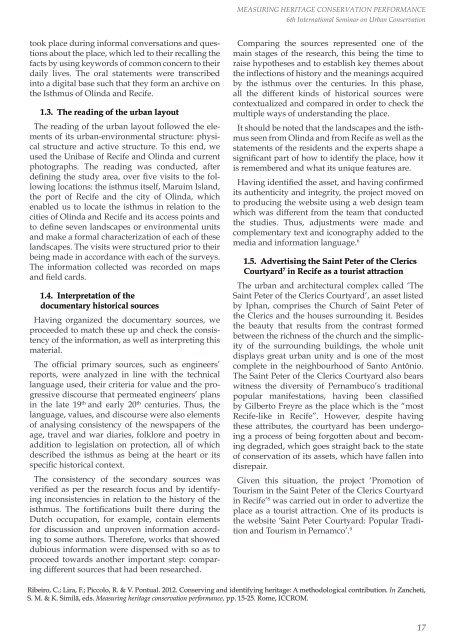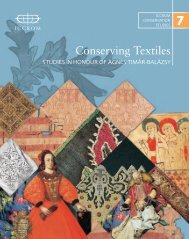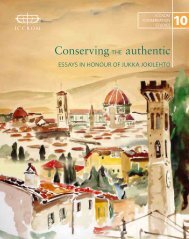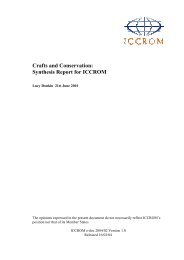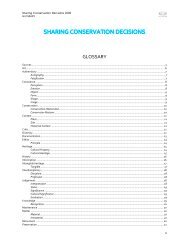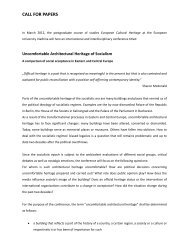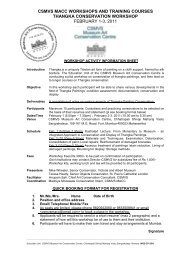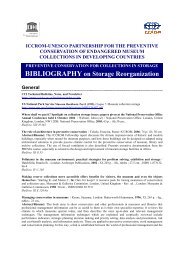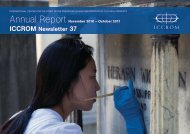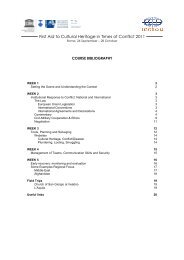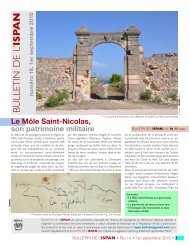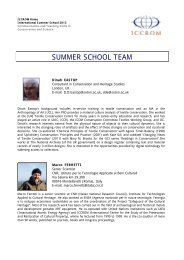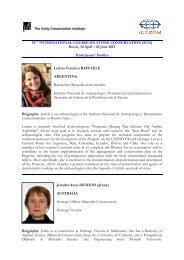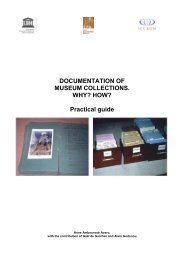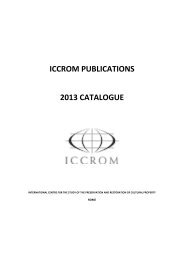part 1 - Iccrom
part 1 - Iccrom
part 1 - Iccrom
Create successful ePaper yourself
Turn your PDF publications into a flip-book with our unique Google optimized e-Paper software.
MEASURING HERITAGE CONSERVATION PERFORMANCE<br />
6th International Seminar on Urban Conservation<br />
took place during informal conversations and questions<br />
about the place, which led to their recalling the<br />
facts by using keywords of common concern to their<br />
daily lives. The oral statements were transcribed<br />
into a digital base such that they form an archive on<br />
the Isthmus of Olinda and Recife.<br />
1.3. The reading of the urban layout<br />
The reading of the urban layout followed the elements<br />
of its urban-environmental structure: physical<br />
structure and active structure. To this end, we<br />
used the Unibase of Recife and Olinda and current<br />
photographs. The reading was conducted, after<br />
defining the study area, over five visits to the following<br />
locations: the isthmus itself, Maruim Island,<br />
the port of Recife and the city of Olinda, which<br />
enabled us to locate the isthmus in relation to the<br />
cities of Olinda and Recife and its access points and<br />
to define seven landscapes or environmental units<br />
and make a formal characterization of each of these<br />
landscapes. The visits were structured prior to their<br />
being made in accordance with each of the surveys.<br />
The information collected was recorded on maps<br />
and field cards.<br />
1.4. Interpretation of the<br />
documentary historical sources<br />
Having organized the documentary sources, we<br />
proceeded to match these up and check the consistency<br />
of the information, as well as interpreting this<br />
material.<br />
The official primary sources, such as engineers’<br />
reports, were analyzed in line with the technical<br />
language used, their criteria for value and the progressive<br />
discourse that permeated engineers’ plans<br />
in the late 19 th and early 20 th centuries. Thus, the<br />
language, values, and discourse were also elements<br />
of analysing consistency of the newspapers of the<br />
age, travel and war diaries, folklore and poetry in<br />
addition to legislation on protection, all of which<br />
described the isthmus as being at the heart or its<br />
specific historical context.<br />
The consistency of the secondary sources was<br />
verified as per the research focus and by identifying<br />
inconsistencies in relation to the history of the<br />
isthmus. The fortifications built there during the<br />
Dutch occupation, for example, contain elements<br />
for discussion and unproven information according<br />
to some authors. Therefore, works that showed<br />
dubious information were dispensed with so as to<br />
proceed towards another important step: comparing<br />
different sources that had been researched.<br />
Comparing the sources represented one of the<br />
main stages of the research, this being the time to<br />
raise hypotheses and to establish key themes about<br />
the inflections of history and the meanings acquired<br />
by the isthmus over the centuries. In this phase,<br />
all the different kinds of historical sources were<br />
contextualized and compared in order to check the<br />
multiple ways of understanding the place.<br />
It should be noted that the landscapes and the isthmus<br />
seen from Olinda and from Recife as well as the<br />
statements of the residents and the experts shape a<br />
significant <strong>part</strong> of how to identify the place, how it<br />
is remembered and what its unique features are.<br />
Having identified the asset, and having confirmed<br />
its authenticity and integrity, the project moved on<br />
to producing the website using a web design team<br />
which was different from the team that conducted<br />
the studies. Thus, adjustments were made and<br />
complementary text and iconography added to the<br />
media and information language. 6<br />
1.5. Advertising the Saint Peter of the Clerics<br />
Courtyard 7 in Recife as a tourist attraction<br />
The urban and architectural complex called ‘The<br />
Saint Peter of the Clerics Courtyard’, an asset listed<br />
by Iphan, comprises the Church of Saint Peter of<br />
the Clerics and the houses surrounding it. Besides<br />
the beauty that results from the contrast formed<br />
between the richness of the church and the simplicity<br />
of the surrounding buildings, the whole unit<br />
displays great urban unity and is one of the most<br />
complete in the neighbourhood of Santo Antônio.<br />
The Saint Peter of the Clerics Courtyard also bears<br />
witness the diversity of Pernambuco’s traditional<br />
popular manifestations, having been classified<br />
by Gilberto Freyre as the place which is the “most<br />
Recife-like in Recife”. However, despite having<br />
these attributes, the courtyard has been undergoing<br />
a process of being forgotten about and becoming<br />
degraded, which goes straight back to the state<br />
of conservation of its assets, which have fallen into<br />
disrepair.<br />
Given this situation, the project ‘Promotion of<br />
Tourism in the Saint Peter of the Clerics Courtyard<br />
in Recife’ 8 was carried out in order to advertize the<br />
place as a tourist attraction. One of its products is<br />
the website ‘Saint Peter Courtyard: Popular Tradition<br />
and Tourism in Pernamco’. 9<br />
Ribeiro, C.; Lira, F.; Piccolo, R. & V. Pontual. 2012. Conserving and identifying heritage: A methodological contribution. In Zancheti,<br />
S. M. & K. Similä, eds. Measuring heritage conservation performance, pp. 15-25. Rome, ICCROM.<br />
17


